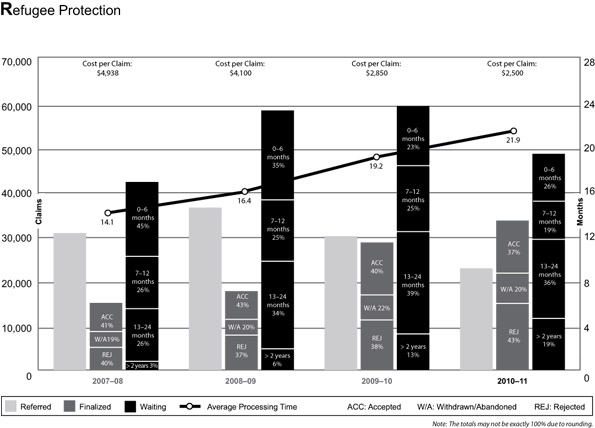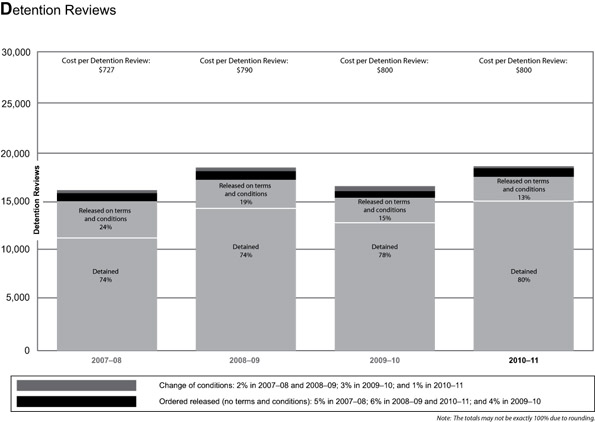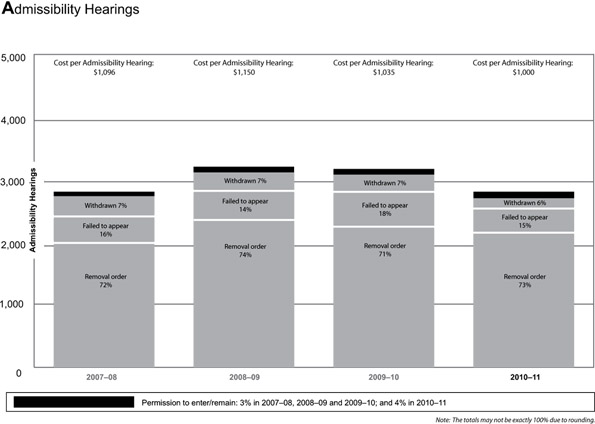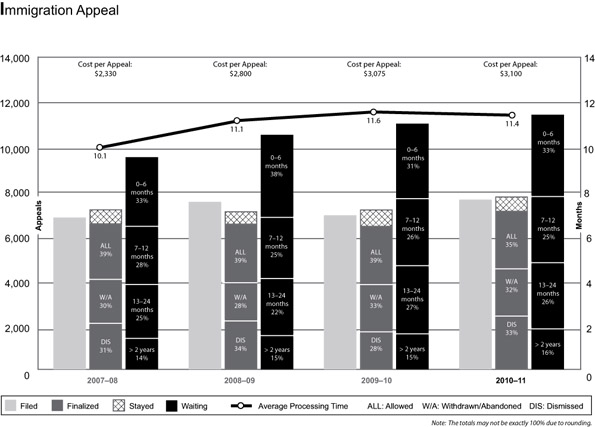Common menu bar links
Breadcrumb Trail
ARCHIVED - Immigration and Refugee Board of Canada - Report
 This page has been archived.
This page has been archived.
Archived Content
Information identified as archived on the Web is for reference, research or recordkeeping purposes. It has not been altered or updated after the date of archiving. Web pages that are archived on the Web are not subject to the Government of Canada Web Standards. As per the Communications Policy of the Government of Canada, you can request alternate formats on the "Contact Us" page.
Section II: Analysis of Program Activities
Strategic Outcome
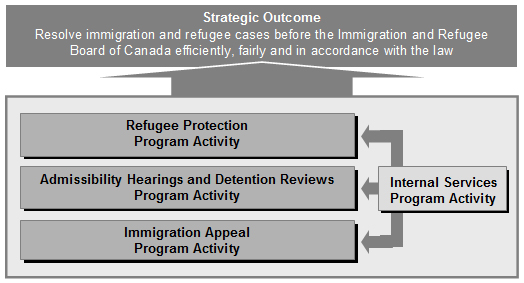
2010-11 Highlights
- Strategic outcome successfully achieved
- Exceeded funded case resolutions in all program activities; over 62,000 cases heard
- Fewer than 0.4% of decisions overturned by the Federal Court
IRB program activities are designed to support the achievement of the strategic outcome. Based on its legislated mandate and approved PAA, the IRB has a single strategic outcome: resolving immigration and refugee cases efficiently, fairly and in accordance with the law. Each of the three core program activities is focused on the resolution of different types of cases before the Board. Combined, they include responsibility for all tribunal decisions and case resolutions, and for a successful outcome.
The realization of the strategic outcome is dependent on both the quantity and the quality of the output, i.e. tribunal resolutions. For instance, a large number of cases must be finalized each year in order to avoid creating a backlog and ensuing delays for individuals waiting for a decision on their case. At the same time, the quality and fairness of each decision must be maintained.
The following pages provide a performance summary and information on overall financial and human resources for the IRB's four program activities during the 2010-11 reporting period.
Program Activity 1: Refugee Protection
Description
The Refugee Protection Division (RPD) delivers the IRB's Refugee Protection program activity. It determines claims for refugee protection made in Canada. Processing of refugee protection claims is the largest of the IRB's activities and demands the majority of its resources. Through the work of the RPD, Canada fulfills its obligations as a signatory to a number of
international human rights conventions.
Additional information on the RPD is available at
www.irb-cisr.gc.ca/eng/tribunal/rpdspr/pages/index.aspx.
2010-11 Highlights
- 22,700 new refugee protection claims filed, 26% fewer than last year
- 33,400 refugee protection claims resolved, 8,400 more than forecast
- Case inventory reduced from 59,000 to 48,300
| Planned Spending | Total Authorities | Actual Spending |
|---|---|---|
| 57.9 | 65.4 | 63.4 |
| Planned | Actual | Difference |
|---|---|---|
| 565 | 573 | 8 |
| Expected Result: Quality decisions rendered and cases resolved in a timely manner regarding refugee protection claims made in Canada | Performance Status: Exceeded | |
| Performance Indicator |
Target | Performance Summary |
|---|---|---|
| Clarity, completeness and conciseness of IRB reasons for decisions | Develop targets for indicators | Target development ongoing. Validation and reporting to begin in the new refugee determination system during 2012-13. |
| Percentage of cases finalized without a hearing | It was expected that 6 to 8% of cases would meet the criteria to be finalized without a hearing, through more expeditious processes. | 7% |
| Ratio of finalized cases to referred cases | During 2010-11, approximately 25,000 refugee protection claim referrals were expected and the RPD anticipated finalizing 25,000 claims, resulting in a ratio of 100%. | 22,700 claims were referred and 33,400 claims were finalized, resulting in a ratio of 146%. |
| Average cost per claim finalized | $3,200 | $2,500 |
| Average case processing time (from referral to finalization) | The average processing time (from referral to finalization) could increase to 20.5 months as the age of the cases in the inventory continues to grow. | Increased from 19.2 to 21.9 months |
Performance Summary and Analysis
Decision-makers. The sustained appointment and reappointment of decision-makers by the GIC remains the critical success factor for the RPD. During 2010-11, improvements were noticeable in this regard, and the RPD operated with a much-reduced shortfall that varied between 2 and 9 decision-makers from its fully funded regular complement of 127. In addition to its regular complement, 12 decision-makers were appointed in the fall of 2010 to help reduce the number of pending refugee protection claims prior to the coming into force of the BRRA.
Inventory. There were 48,300 refugee protection claims waiting to be heard by the end of 2010-11, which is an 18 percent reduction in the inventory from the last fiscal year. The RPD finalized 33,400 claims in the period under review, a remarkable achievement given that a significant amount of effort was also required to begin preparations for the implementation of the BRRA. In 2010-11, almost 23,000 claims were referred (compared to a projected intake of 25,000 claims). This reduction in intake, the relative continuity in appointments, enhanced productivity, and a high level of withdrawn and abandoned claims have allowed the RPD to decrease its backlog by 14,000 since it peaked at 62,000 in October 2009. During the year, the ratio of finalized cases to referred cases was 146 percent, compared to 95 percent last year. Despite these factors, a significant number of claims will remain pending when the new legislation comes into force. Without additional resources, the IRB will not have the capacity to hear these claims and further reduce this pending inventory in any substantial way under the new system.
Case management. The RPD finalized 33,400 claims in 2010-11, 8,400 claims above the RPP forecast of 25,000 claims. A number of factors contributed to this result: the additional decision-makers appointed under the backlog reduction initiative; case management efficiencies, including enhanced adjudicative support; and continued hearing-readiness efforts.
Lessons Learned
The RPD has piloted accelerated scheduling and scheduling conference initiatives. The first initiative consists of strategically assigning more straightforward hearings to certain decision-makers. During accelerated scheduling weeks, a decision-maker is scheduled 15 straightforward hearings. Typically, the decision-maker renders oral decisions, and a higher number of finalizations are thus achieved than would normally be the case. The second initiative consists of requiring claimants to attend a conference to delineate issues and make sure the case is hearing-ready. The RPD is evaluating the results of both initiatives to determine whether they should be implemented across all regions.
Program Activity 2: Admissibility Hearings and Detention Reviews
Description
The Immigration Division (ID) delivers the Admissibility Hearings and Detention Reviews program activity. It holds hearings for foreign nationals or permanent residents who, under the provisions of the IRPA, are alleged to be inadmissible to Canada or are detained. Detainees must be seen by the ID within 48 hours after their referral, or without delay thereafter, and
subsequent reviews must be conducted within specific statutory time frames. Decision-makers must balance the right to individual liberty with the safety and security interests of Canadians.
Additional information on the ID is available at
www.irb-cisr.gc.ca/eng/tribunal/idsi/pages/index.aspx
2010-11 Highlights
- 2,800 admissibility hearings finalized
- 18,500 detention reviews carried out
- Public Service Award of Excellence
| Planned Spending | Total Authorities | Actual Spending |
|---|---|---|
| 12.7 | 13.4 | 11.0 |
| Planned | Actual | Difference |
|---|---|---|
| 70 | 73 | 3 |
| Expected Result: Quality decisions rendered and cases resolved in a timely manner regarding admissibility hearings and detention reviews | Performance Status: Exceeded | |
| Performance Indicator |
Target | Performance Summary |
|---|---|---|
| Clarity, completeness and conciseness of IRB reasons for decisions | Develop targets for indicators | Target development ongoing; to be validated during Q4 2011-12. Reporting to begin during 2012-13. |
| Percentage of admissibility hearing cases concluded to referred cases | 98%1 | 102% |
| Percentage of concluded detention review cases within statutory time frame | 97%2 | 98% |
| Average cost of admissibility hearing | $900 | $1,000 |
| Average cost of detention review | $800 | $800 |
| Percentage of admissibility hearings concluded with a hearing within six months from referral | 88% | 93% |
1 Detention reviews take priority over admissibility hearings due to legislative time requirements. The number of referrals from the CBSA will affect the capacity to conduct admissibility hearings.
2 Factors outside the IRB's control, such as prison lock-down, impede the achievement of 100% compliance.
Performance Summary and Analysis
Sustained and more complex workload. The number of cases concluded by the ID depends largely on the number of cases referred by the CBSA. During 2010-11, the ID experienced a 9 percent decrease in referrals for admissibility hearings while the number of detention reviews increased by 11 percent. A growing number of admissibility hearings and detention reviews involved more complex and novel issues. For example, complex cases involving classified information related to national security and criminal intelligence require a disproportionate level of coordination and effort from decision-makers and registry, security and legal staff. Through continued efficiencies and some additional resources, the ID increased its output and concluded almost all cases within the legislated time frames for detention reviews.
Detention reviews represented 87 percent of the Division's caseload. Of particular note, the number of detention reviews in the Western Region increased by 116 percent, a direct result of the arrival of the MV Sun Sea carrying 492 migrants from Sri Lanka in August 2010. The ID prioritized detention reviews to ensure that legislative requirements and the fundamental rights of the persons concerned were respected.
Effective case management. Throughout the year, the ID monitored its case inventory closely. By applying scheduling standards, the Division ensured that established productivity targets were met. Further enhancements of effective case management practices allowed the ID to maintain reduced rates of adjournments and postponements, to reduce processing times and to increase its capacity to resolve cases in a timely fashion. Significant divisional resources, and not only those of the Western Region, were also focused on ensuring the timely processing of detention reviews and admissibility hearings stemming from the arrival of migrants aboard the MV Sun Sea.
Lessons Learned
In all of its activities, the ID exceeded expectations. Despite an overall increase in detention reviews, notably in the Western Region, the ID exceeded its performance targets. The challenges facing the Division due to the arrival of the MV Sun Sea were immense; however, the Division was able to meet its legislated time frames because it worked quickly to secure additional short-term resources, move Eastern Region and Central Region decision-makers to the Western Region for short-term assignments, and shift some work from the Western Region to the other two regions on a temporary basis.
The Division's dedicated and professional workforce, along with a number of other IRB personnel, was honoured with the Public Service Award of Excellence recognizing "Exemplary Contribution Under Extraordinary Circumstances" for their handling of the unanticipated influx of marine migrants.
Securing high-quality decision-makers will remain a key element in the Division's future success.
Program Activity 3: Immigration Appeal
Description
The Immigration Appeal Division (IAD) delivers the Immigration Appeal program activity. It hears immigration appeals from Canadian citizens and permanent residents whose applications to sponsor close family members to Canada have been refused. Other key functions include hearing appeals from permanent residents, foreign nationals with a permanent resident visa, protected
persons who have been ordered removed from Canada, and permanent residents outside Canada who are alleged to have not fulfilled their residency obligation.
Additional information on the IAD is available at
www.irb-cisr.gc.ca/eng/tribunal/iadsai/pages/index.aspx
2010-11 Highlights
- 7,600 new immigration appeals filed
- 7,100 immigration appeals finalized and 660 stays issued
- Case inventory increased from 10,900 to 11,400
- Average processing time decreased from 11.6 to 11.4 months
| Planned Spending | Total Authorities | Actual Spending |
|---|---|---|
| 14.6 | 16.7 | 16.4 |
| Planned | Actual | Difference |
|---|---|---|
| 120 | 124 | 4 |
| Expected Result: Quality decisions rendered and cases resolved in a timely manner regarding immigration appeals | Performance Status: Met All | |
| Performance Indicator |
Target | Performance Summary |
|---|---|---|
| Clarity, completeness and conciseness of IRB reasons for decisions | Develop targets for indicators | Target development ongoing; to be validated during Q4 2011-12. Reporting to begin during 2012-13. |
| Percentage of appeals finalized without a hearing | It was expected that 43% or more of appeals would be finalized without a hearing. | 39% |
| Ratio of finalized appeals to filed appeals | Approximately 7,400 appeals were expected to be filed in 2010-11. Based on the number of decision-makers available, we expected to finalize 6,500 appeals, resulting in a ratio of 88%. | 7,600 appeals were filed and 7,100 were finalized, resulting in a ratio of 93%. |
| Average cost per appeal finalized | $3,100 | $3,100 |
| Average appeal processing time | Based on the inventory, it was expected that the average processing time would increase to 12 months in 2010-11. | Decreased from 11.6 to 11.4 months |
Performance Summary and Analysis
Decision-makers. In 2010-11, the IAD operated with close to its full complement of decision-makers. Although the majority of IAD decision-makers were in their first mandate, with some in their initial training period, the Division significantly exceeded its projected target of 6,500 finalizations. For the first time in IAD history, 7,100 appeals were finalized and 660 stays issued, reflecting outstanding productivity by the decision-makers and adjudicative support personnel.
Inventory. The IAD intake of appeals was slightly more than forecast, with 7,600 appeals filed in 2010-11, and the inventory of appeals awaiting finalization increased to 11,400. The Division will continue to identify efficiencies in its procedural, adjudicative and administrative practices; however, productivity is most affected by the number of decision-makers available to resolve appeals.
Case management. The IAD continued to respond in a flexible manner to match resources with regional caseloads by sharing decision-makers among regions and by conducting hearings via videoconference where appropriate. Case management strategies focused on increasing early resolution of appeals without a hearing, enhancing hearing readiness, scheduling appeals strategically to increase efficiencies, and monitoring reasons for postponements and adjournments. The IAD remains committed to producing quality decisions that are made in a timely manner.
Portfolio linkages. The IAD has kept working with the CBSA to quickly finalize appeals that the CBSA had screened for early resolution and to facilitate the hearing of appeals where the Minister's counsel had chosen to participate through written submissions only. Work undertaken with the CBSA on case management innovations continued, as always, to respect the adjudicative independence of IAD decision-makers.
Lessons Learned
The need to coordinate resources with the CBSA remains crucial to the work of the IAD. We have learned that regular consultative meetings attended by representatives of the IAD, counsel and the CBSA facilitate creative problem-solving that can lead to optimized resource allocation. Strong adjudicative support remains important for sustaining high productivity through increased hearing readiness and early resolution of cases. Despite the record-high decision-maker productivity in 2010-11, we realize that the average appeal processing time will only decrease when more appeals are resolved without a hearing. The IAD will capitalize on these lessons and continue to improve its efficiency and productivity.
Program Activity 4: Internal Services
Description
Internal Services are groups of related activities and resources required to support the needs of all three tribunal programs and other corporate obligations of the IRB. These services are: Management and Oversight; Communications; Legal; Human Resources Management; Financial Management; Information Management; Information Technology; Procurement and Assets Management;
Internal Audit and Evaluation; and other administrative services. Internal Services include only those activities and resources that apply across the organization and not those provided to a specific program.
2010-11 Highlights
- Reform implementation planning supported
- HR staffing practices strengthened
- Measures for the quality of decisions piloted
| Planned Spending | Total Authorities | Actual Spending |
|---|---|---|
| 31.9 | 35.3 | 34.8 |
| Planned | Actual | Difference |
|---|---|---|
| 270 | 253 | (17) |
Performance Summary and Analysis
Management and oversight. During 2010-11, the IRB focused on two specific areas of management and oversight: staffing and systems development.
- The Public Service Commission (PSC) Report on the Agreement on Follow-up to the Audit (2009) is expected in the fall. The PSC acknowledged the significant progress made by the IRB in strengthening its staffing practices and in providing training and guidance to hiring managers so that staffing processes clearly respect the core and guiding values of the Public Service Employment Act (PSEA). An internal quality assurance process was also implemented, whereby an independent assessment of all appointment files was undertaken to ensure that all requirements of the PSEA and relevant policies were met prior to proceeding with the offer to appoint.
- The IRB contracted an outside consulting firm to carry out a third-party independent review of the IRB's System for Tracking Appeals and Refugees (STAR) Modernization Project. The review provided the IRB with a better understanding of the project parameters and the dependencies inherent in its successful completion. The results of this independent review also provided the Treasury Board Secretariat (TBS) with the assurance it was seeking prior to granting the authority for the modernization project.
Communications. During the reporting period, the IRB took part in numerous outreach events ranging from national and international conferences to stakeholder consultations and intergovernmental meetings on a variety of issues, including refugee reform. Participation in these events promoted exchanges on key policy and procedural issues and resulted in improved communication and cooperation between IRB personnel and major stakeholders, key government partners and the Canadian public.
Legal. During 2010-11, IRB Legal Services continued to provide ongoing support for the implementation of the BRRA. Key activities included the development of new rules of practice and procedure for the RPD and the RAD, and related advice and support. In Vancouver, Legal Services provided strategic operational advice and decision-making support in response to the nearly 500 MV Sun Sea marine arrivals. Nationally, Legal Services continued to provide advice and guidance on all aspects of operations, service delivery, policy development, corporate direction and management decisions to ensure compliance with all relevant legal requirements. This included advice on the impact of Bill C-35, An Act to Amend the Immigration and Refugee Protection Act (formerly called the Cracking Down on Crooked Consultants Act), which received Royal Assent on March 23, 2011. Continued support and advice on complex cases involving classified information related to national security and criminal intelligence was also provided during the reporting period. Legal Services maintained its ongoing training and support of newly appointed decision-makers in all the divisions, including by providing advice, conducting risk analyses and reviewing adjudicative strategies.
Human resources management. In preparing for the successful implementation of the BRRA, the IRB developed its human resources (HR) plan to ensure that it continues to foster an environment where people management is valued and recognized as a priority. The plan spans the period from 2010-11 to 2012-13 and is an integral component of the organization's management framework. The 2010-11 HR priorities lay the groundwork for the creation of the new organization and for the support of existing and incoming IRB personnel by realigning other operational deliverables in the areas of classification, staffing and professional development. In addition, the IRB continued to build the capacity of its HR community and to address the findings of the 2009 PSC staffing audit. As the largest federal administrative tribunal in Canada, the IRB faces particular challenges arising from its mix of decision-makers and support personnel. However, it remains committed to excellence in all of its HR activities and to full compliance with applicable legislation, guidelines and policies.
Financial management. During 2010-11, the main focus of financial management was the planning and budgeting efforts necessary to prepare for the implementation of the BRRA. In addition, measures were taken to prepare for the TBS Policy on Internal Control. A risk assessment of financial reporting accounts and documentation of financial control processes were undertaken, which will enable the Board to fully implement the policy in 2011-12, as required by TBS. Future-Oriented Financial Statements were prepared and published with the 2011-12 RPP in accordance with a new TBS requirement to provide better accrual-based financial information on Government expenditures. The IRB also implemented a process for the publication of quarterly financial reports, a requirement of the Financial Administration Act that becomes effective in 2011-12.
Information management. The implementation of the new IRB function-based classification structure was postponed due to a shift in workload priorities associated with the new legislation. The Chief Information Officer (CIO) role was defined, and an information management (IM) maturity review was conducted within the Board. This review confirmed that much work remains to be done. For example, IM infrastructure needs require further definition. Document and record management processes and tools also require attention and improvements. During the next reporting period, the CIO will develop a comprehensive plan and will also implement enabling technology in support of the Board's IM strategy.
Information technology. In 2010-11, information technology (IT) at the IRB was shaped by new and emerging business priorities, as well as ongoing systems and infrastructure maintenance and upgrades. IT efforts were focused on supporting reform implementation by providing adequate IT infrastructure support. IT also supported the successful release and implementation of the Interactive Scheduling Interface, a new scheduling tool for the RPD, and the effective and timely development of NOVA, formerly named the STAR Modernization Project.
Procurement and assets management. During 2010-11, the IRB's procurement program continued to assist clients in developing their procurement strategies to be effective, flexible and provide best value to the Crown. As functional specialists, procurement officers were given access to specialized training, as required by PWGSC and TBS. Disposal efforts for IT and non-IT assets deemed surplus were undertaken while adhering to the requirements of the Computers for Schools program, the PWGSC GC Surplus initiative, and the provincial and PWGSC e-waste recycling programs.
Internal audit. In 2010-11, the new IRB Internal Audit Charter and the IRB Audit Committee Charter were developed, in accordance with the guidelines and directives of the amended TBS Policy on Internal Audit (July 2009). In addition, the IRB developed its three year Risk-Based Audit Plan, which identifies the risk areas for the organization, as well as the audits and reviews that will be accomplished during the three-year time frame.
Evaluation. The IRB's preparations to implement the BRRA and the supporting NOVA system took into account the key recommendations of a recent evaluation to improve the effectiveness and efficiency of the IRB's scheduling practices. The IRB has also been collaborating with its portfolio partners in planning the three-year horizontal evaluation of the new refugee system and key metrics to monitor it on a regular basis. The IRB developed and piloted an innovative performance measurement system to measure the quality of decisions rendered by the Board. Following a successful pilot and very positive feedback, full implementation was planned and will begin in the next reporting period.

